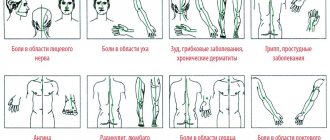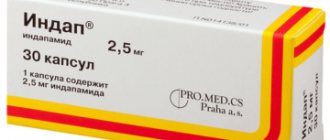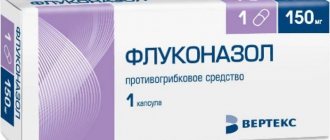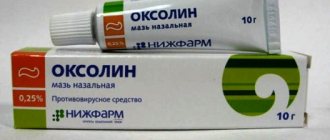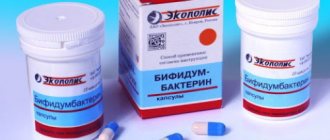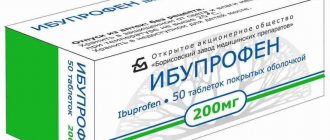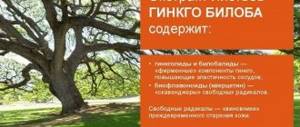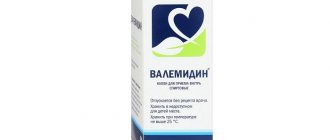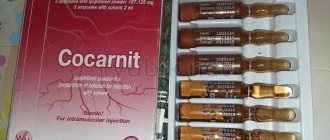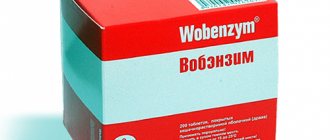Pharmacological group
Grisoefulvin is a waste product of penicillin mold fungi. It has a fungistatic effect by inhibiting the growth and reproduction of various other fungi. The therapeutic effect is realized due to the disruption of protein synthesis processes (disruption of communication with messenger RNA) in fungal cells, as well as their division during metaphase (the process of formation of the mitotic spindle is disrupted). To a greater extent, the drug is active against chitin-containing fungi (epidermophytes, microspores, trichophytons).
After taking the tablet orally, griseofulvin is almost completely absorbed into the blood. It is evenly distributed in tissues, accumulates well in the skin and its appendages (nails, hair), adipose tissue, and liver, where it has therapeutic effects. The compound is metabolized in hepatocytes. Inactive breakdown products are excreted primarily in the urine.
The drug Griseofulvin
The medication is a highly dispersed form of an antifungal antibiotic produced by mold fungi of the genus Penicillium - Penicillium nigricans. Minimal concentrations of the product have a fungistatic effect, stopping the growth and development of pathogens. At the same time, large doses of antibiotic completely destroy colonies of fungal microorganisms.
Composition and release form
The active component of the drug is griseofulvin. Depending on the dosage form of the antibiotic (tablets, 2.5% ointment or suspension), certain excipients are additionally included in the medication, for example, lactose monohydrate or salicylic acid. Therapy for fungal diseases is mostly carried out by oral administration of the drug, which is determined by the ease of use (compliance) of the dosage form.
The tablets are sold in blister packs of 10 pieces. A cardboard pack contains 20 pills. According to the instructions for use, the concentration of the active substance in 1 tablet reaches 125 mg. In addition to the main component, the drug includes:
- povidone;
- lactose monohydrate;
- corn starch;
- polyethylene glycol;
- Magnesium stearate.
Pharmacodynamics and pharmacokinetics
The therapeutic effect of the drug is achieved through the damaging effect of the active substance on the formation of the mitotic spindle during the division of fungal cells. Griseofulvin blocks the synthesis of protein structures necessary for the development of the microorganism, thereby causing its death. The antimycotic agent is active against fungi of the following genus:
- Microsporum;
- Trichophyton;
- Epidermophyton.
The instructions for use indicate that after taking the tablet, the active substance is almost completely absorbed into the systemic bloodstream from the intestine. The drug is characterized by predominant accumulation in the skin, its appendages, adipose tissue, liver and skeletal muscles. Griseofulvin is metabolized in liver cells to form inactive breakdown products. Excretion of the latter is carried out mainly by the kidneys.
- Professional skills in a resume: examples of skills and knowledge
- Pike perch baked in the oven: recipes
- Is it possible to sleep with your feet towards the door?
Indications for use
The drug is prescribed for the treatment of infections caused by species of fungal microorganisms sensitive to the active component of the drug. The medication is recommended for people suffering from dermatomycosis of any localization. The drug is effective against nail fungus, or onychomycosis. In addition to the indicated indications, the instructions for use recommend using the drug for the following conditions:
- epidermophytosis of the skin;
- favuse (fungal infection of the scalp);
- microsporia;
- athlete's foot and hands caused by Trichophyton rubrum, Trichophyton interdigitale;
- trichophytosis (infection of smooth scalp);
- severe mycoses of the skin.
Indications for use
The medicine is prescribed for etiotropic therapy of fungal infections, aimed at suppressing the growth and reproduction of pathogens sensitive to griseofulvin.
for adults
The drug is used for the following mycoses of hair, nails and skin:
- Favus.
- Microsporia of smooth skin.
- Dermatomycosis of the beard and mustache.
- Athlete's foot.
- Onychomycosis.
- Trichophytosis.
- Microsporia of the scalp.
- Athlete's disease of smooth skin.
- Inguinal athlete's foot.
for children
The medicine is prescribed to children over 2 years of age with a body weight of more than 25 kg for the same medical reasons.
for pregnant women and during lactation
The use of medication is excluded.
Pharmacological properties of the drug
What is the mechanism of action of the drug "Griseofulvin"? Instructions for use and reviews of this medication inform patients that it is an antifungal agent. This drug has a fungistatic effect (aimed at stopping the growth and development of parasitic fungi) on:
- various types of lermatomycetes - parasitic fungi that cause skin diseases;
- microsporums (that is, parasitic fungi that are causative agents of microsporia in humans);
- trichophytons, that is, parasitic fungi that are causative agents of skin and nail diseases (mainly the scalp);
- epidermophytons (that is, parasitic fungi - the causative agents of epidermophytosis in humans, or more precisely, inflammatory lesions of the skin of the feet, groin area and nails).
Contraindications
There are several pathological and physiological conditions in which the use of the drug is excluded:
- Porphyria (metabolic disorder).
- Lupus-like syndrome.
- Decrease in the number of leukocytes in the blood.
- Liver failure of varying severity.
- Circulatory disorders in the brain.
- Uterine bleeding of various origins in women.
- The child is under 2 years old and weighs less than 12 kg.
- Systemic lupus erythematosus.
- Systemic blood pathology of various origins.
- Acute and subacute liver pathology, accompanied by a violation of the functional state of the organ.
- Malignant neoplasms.
- Condition after a cerebral stroke.
- Pregnancy regardless of stage and breastfeeding.
Applications and dosages
The tablets are intended for oral use during or after meals that include vegetable oil. They are not chewed and washed down with enough water to pass through the esophagus.
for adults
The average recommended dose ranges from 500 to 1000 mg of griseofulvin per day. The course of treatment depends on the severity of mycosis, it varies from 2-4 weeks to 1 year. Typically, at the beginning of treatment, the medicine is used daily until the first negative tests for a fungal infection are obtained. Then the tablets are taken at the same dose every other day for a long period of time (several weeks).
for children
For children over 2 years of age with a body weight of more than 25 kg, the medicine is prescribed at the rate of 16-22 mg per 1 kg of the child’s body weight. The duration and regimen of taking the medication are not fundamentally different.
for pregnant women and during lactation
The medicine is contraindicated for use in this category of patients.
Griseofulvin for children
The instructions for use indicate that the antibiotic in the form of a suspension can be prescribed to young patients starting from three years of age. For the treatment of infiltrative-purulent and superficial forms of lichen, Griseofulvin is taken at the rate of 18 mg of the drug for each kg of the child’s body weight. For fungal infections of the head or nails, the daily dosage is 16 mg/kg. The duration of the course of treatment is approximately 8 months. Griseofulvin ointment is not used to treat children under 14 years of age.
- How to weave macrame bracelets
- Rabbit in a slow cooker
- Waffle rolls - a recipe for an electric waffle iron. Recipes for dough and filling for waffle rolls with photos
Side effects
After starting to take the pills, the development of undesirable side reactions from several organ systems cannot be ruled out:
- Digestive system - nausea, periodic vomiting, diarrhea, stomach pain, hepatitis (inflammation of the liver), candidal infection of the oral cavity.
- Nervous system - headache of varying severity, disorientation in time and space, insomnia, increased fatigue, weakness, periodic dizziness, impaired coordination of movements, damage to peripheral nerves, confusion, impaired skin sensitivity.
- Blood and red bone marrow – absence of granulocytes, decreased number of leukocytes, granulocytes.
- Allergic reactions - skin rash, the formation of which is accompanied by itching, urticaria, angioedema, increased sensitivity of the skin to light, exudative erythema multiforme, Lyell's syndrome, lupus-like syndrome.
Side effects
Judging by the reviews, Griseofulvin can cause disruption of the digestive system and dyspeptic disorders. The instructions for use indicate that in rare cases, stool disorder (constipation, diarrhea) occurs. From the central nervous system, headaches, asthenovegetative and neurological symptoms may appear. In rare situations, it is possible to develop increased susceptibility to visible light and ultraviolet rays. Along with this, taking Griseofulvin is fraught with the following side effects:
- neuropathy;
- nausea, vomiting;
- candidal stomatitis;
- leukopenia;
- agranulocytosis;
- allergic reactions.
special instructions
After you start taking the pills, you should definitely take into account several special instructions for the correct use of the medicine, these include:
- When taking the drug for a long time, laboratory monitoring of the picture and morphological composition of peripheral blood should be carried out every 10-15 days.
- For fungal infections of the nail plates, it is recommended to combine taking tablets with removing the affected areas, as well as using antifungal agents for local use in the form of cream, ointment or nail polish.
- During the complex treatment of mycosis of the scalp, it is recommended to simultaneously shave the hair weekly, use external antifungal agents, and treat the foci of the pathological process with a 2-3% iodine solution in the form of a tincture.
- Since the development of negative reactions from the structures of the central nervous system cannot be excluded, potentially dangerous work associated with the need for sufficient concentration of attention and speed of psychomotor reactions should be performed carefully.
Analogs
On the modern pharmaceutical market there are structural analogues for Griseofulvin tablets.
Fulcin
The medication is prepared in tablet form for oral administration. It is used for the purpose of etiotropic therapy of fungal infections in adults and children over 2 years of age. The drug is contraindicated during pregnancy and lactation.
Griseofulvin-forte
The medicine has the same dosage of the active ingredient. It is available in tablet form and is prescribed for the treatment of fungal infections caused by susceptible pathogens. The drug is contraindicated in children under 2 years of age, pregnant and breastfeeding women.
Compound
The active component is griseofulvin, an antifungal antibiotic produced by the mold Penicillium nigricans (griseofulvum).
Excipients:
- Potato starch is a filler that improves the process of tablet compression and accelerates the process of breakdown of the dosage form in the gastrointestinal tract. To a lesser extent, it reduces the irritating effect of the active substance on the gastric mucosa.
- Milk sugar (lactose) is a filler in the dosage form. Calcium stearate is a filler. Low molecular weight polyvinylpyrrolidone (povidone) is a binding component.

